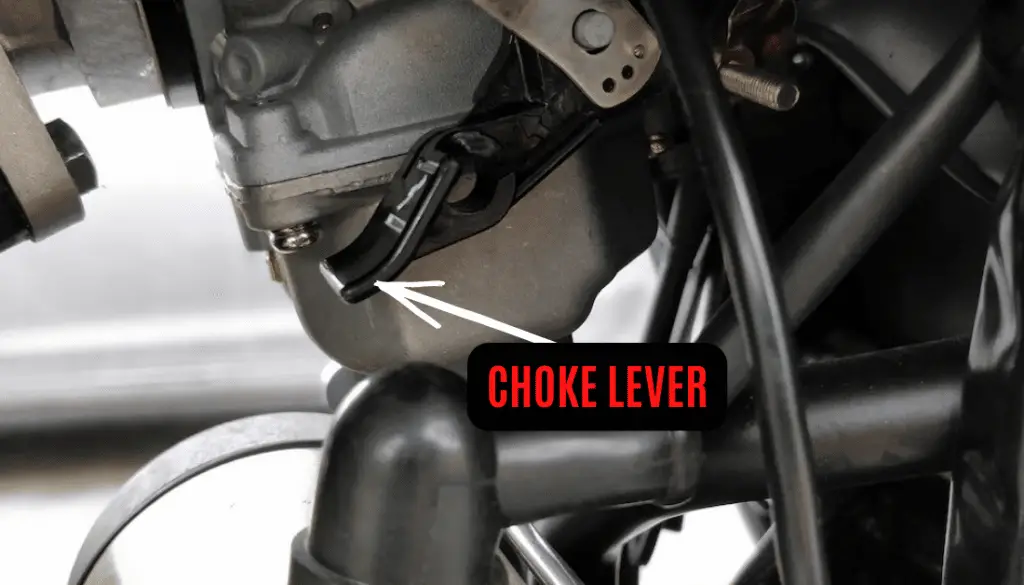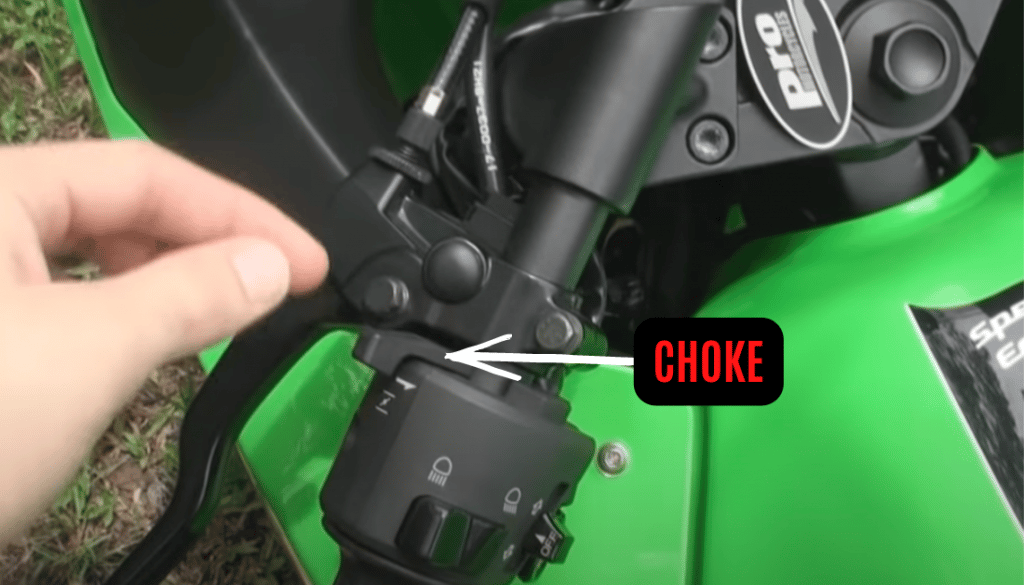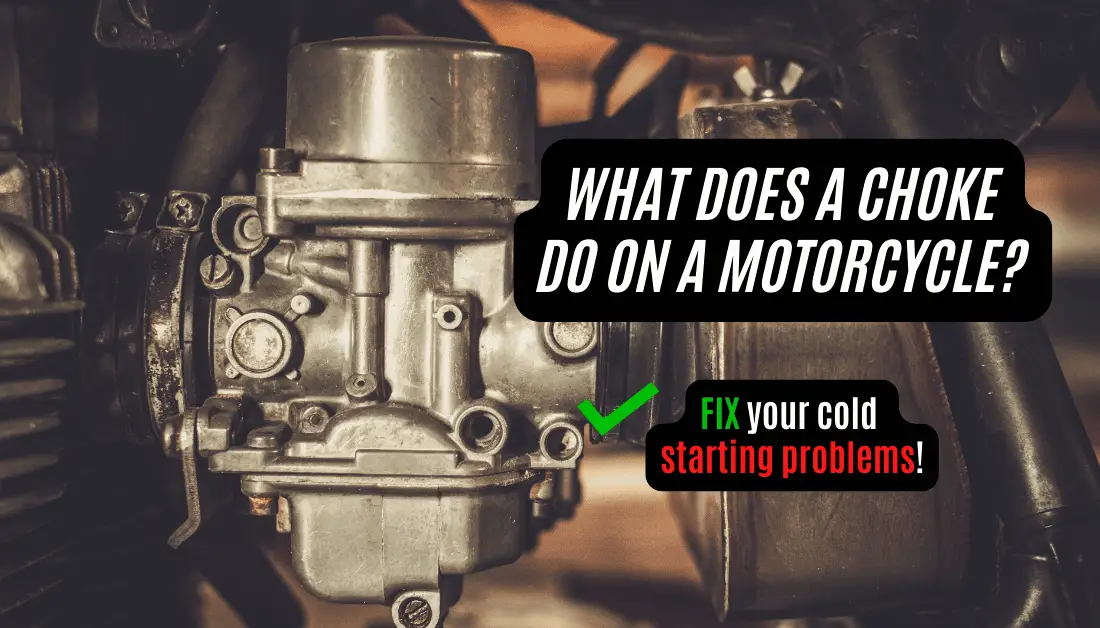Growing up, my family had a Honda 100cc motorcycle (tiny engine!). I’d hear my dad throw around the phrase “use the choke,” — especially in the winters when it wouldn’t start.
Magically, it would when the choke was engaged. I often wondered but never asked, what does the choke do on a motorcycle?
The choke on a motorcycle constricts the flow of air into the carburetor. As a result, more fuel draws into the carburetor leading to an enriched fuel-air mixture. This helps to start a motorcycle with a cold engine.
Table of contents
Different types of chokes on carbureted engines and how they work
Older motorcycles with carburetors have two types of chokes.
Manual Choke
This works as I described above. It partially closes and constricts the air intake (hence the word “choke”) into the carburetor, which sends less air but increases the velocity/speed of the air being let into the carburetor.
In turn, this causes more fuel to be sucked into the carburetor from the pilot jet because of an increase in the existing Venturi effect.
Ultimately, we have a fuel-rich mixture in the carburetor.
A rich fuel mixture means more vaporized fuel particles are being sent to the motorcycle engine. This makes it easier to crank the engine, especially in cold conditions.
In cold weather conditions, the cold fuel vapors vaporize at a slower rate than ideal. Therefore the number of fuel particles in the combustion chamber is less than needed to sustain combustion.
By increasing the fuel supply to the engine, the vaporized fuel particles also increase, and it becomes easier to crank the engine.
This is only required the first time that you start your motorcycle on a cold day. But if you let it cool down for a very long time, then you might need to use the choke again.
The choke lever is usually on the carburetor or on or near the handlebars. It has to be opened and closed manually.
Dirt bike owners for one are familiar with manual chokes.
Here’s a picture ???? of a motorcycle choke directly on the carburetor as a lever.

Here’s another picture ???? of the choke, but this time, it is on the handlebars and is connected via a choke cable to the carburetor.

Tip ????: for carburetors, once you are done riding, and won’t for a few days, cut off the fuel line and let the bike idle until the carburetor stalls. Then there is no ethanol fuel left in the jets to clog up.
Automatic Choke (Enricher)
This enricher circuit is not a choke, technically speaking. This method increases the fuel supply to the carburetor, and that creates a fuel-rich mixture.
It does increase the supply of fuel into the carburetor but not by “choking” the air supply — hence this is not a choke.
It simply adds more fuel to whatever amount of air was already being let into the carburetor by the operation of its plunger.
The auto choke jumps into action based on the heat sensors of the engine.
If the temperature is below ideal for engine cranking, then this choke is activated, letting in more fuel.
As the temperature reaches an ideal state, it starts to correct and shut itself off.
So you cannot operate this type of choke manually. This is tied to heat sensors on your bike.
Choke on modern motorcycles with EFI (Electronic Fuel Injection)
Modern motorcycles don’t have carburetors. They don’t have a choke!
Instead, they use what we call Fuel Injectors to send fuel into the combustion chamber.
On such motorcycles, the ECU (Engine Contol Unit) dynamically handles the ratio of fuel to air, and there is no function of the choke.
It will send more fuel through the fuel injectors when needed, such as in cold situations, based on maps or lookup tables. These tables are preset by your motorcycle manufacturer with various inputs on temperatures.
I know this for a fact on both my ZX-10R and Z900.
When I start either of them, they typically reach higher idling RPMs as the ECU sends extra fuel. As the temperature rises from 40 degrees Celcius to 68 degrees Celsius, the idling RPM first goes up and then begins to fall. Once in the 60s temperature range, the RPM comes down to the expected idling frequency. As it does, the ECU cuts off the extra fuel.
You cannot operate this manually. The ECU takes care of this.
And it works just fine.
While carburetors develop issues every now and then, fuel injectors controlled by ECUs seem to last forever.
Why do I need to use a choke?
If you have a carbureted engine and live in a cold country or at least one with cold weather, then YES–you will need a choke.
In cold weather conditions, the best way to start an engine is to use the full choke.
The resulting rich fuel mixture will help crank and initiate sustainable combustion.
Once the engine’s temperature rises, and it can sufficiently vaporize the fuel that is entering the combustion chambers, the choke is no longer required. Past the initial opening of the throttle, the pilot jet will give way to the main jet to take over and supply fuel from the float bowl.
Good luck cranking the engine without a choke in cold weather with low temperatures!
However, if you live in warm weather all year round, you would rarely ever need the function of the choke.
Can I use the choke on a warm engine?
Yes, you can, but there is absolutely NO need.
The main reason for using the choke is to facilitate the initial cranking of the engine while it is cold by making the fuel ratio to air high — rich.
Once warm, the engine does need any help to keep running. The very purpose of the choke is defeated if you use it when the engine is already warm.
Additionally, you will cause excessive fuel consumption.
If your motorcycle has a manual choke, turn off/disengage the choke once the engine is warm enough.
Or else, you will waste fuel and may cause the motorcycle exhaust to backfire.
What will happen if I leave the choke on for longer than required?
Nothing.
Yes, nothing will happen if you forget to disengage the choke sometimes. Your engine won’t go up in flames.
But that doesn’t mean you want to do it all the time.
If you always leave the choke on, you risk unnecessary engine wear.
And, of course, you will waste a lot of fuel.
Conclusion
The choke is vital to a carbureted motorcycle.
No question about that.
And for those living in cold countries, you know your chokes like the back of your hand.
That’s because you must use them every time you try cold starting your bike! ????
